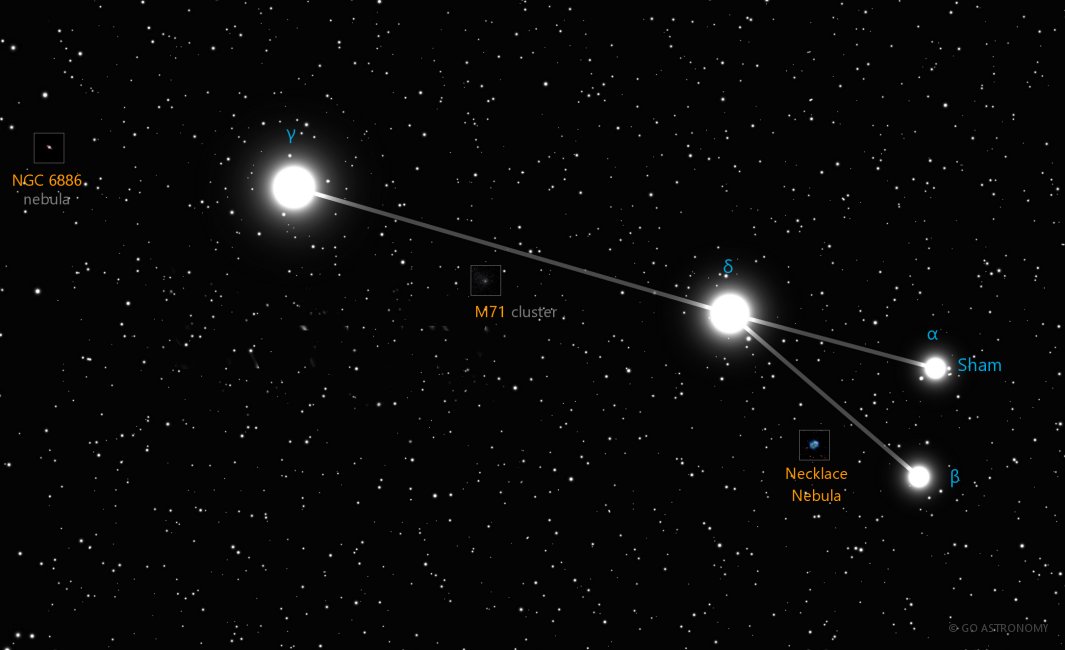Sagitta, the Arrow (Sge)
(suh-JIT-uh)
The Northern constellation of Sagitta, the Arrow, is best viewed in Fall during the month of September.
Sagitta is the 86th largest constellation. It's brightest star is Gamma Sagittae at magnitude 3.51. The boundary of the Sagitta constellation contains 2 stars that host known exoplanets.
- Pronunciation:
- suh-JIT-uh
- Meaning:
- Arrow
- Genitive:
- Sagittae
- Abbreviation:
- Sge
- Hemisphere:
- Northern
- Quadrant:
- NQ4
- Visibility:
- 90° N - 70° S
- Best viewing month*:
- September
- Area:
- 80 sq. degrees
- Size:
- 86th largest
- Right Ascension (avg):
- 19h 40m
- Declination (avg):
- 18°
- Brightest star:
- Gamma Sagittae (3.51)
- Stars with planets:
- 2
- Caldwell objects:
- |
Brightest Stars in Sagitta
The 10 brightest stars in the constellation Sagitta by magnitude.
- Star
- Magnitude
- Spectral class
- Gamma Sagittae (γ Sge)
- 3.51
- K5III
- Delta Sagittae (δ Sge)
- 3.82
- M2II + B6
- Alpha Sagittae (α Sge)
- 4.38
- G0II
- Beta Sagittae (β Sge)
- 4.38
- G8II
- Zeta Sagittae (ζ Sge)
- 5.01
- A3V
- Eta Sagittae (η Sge)
- 5.09
- K2III
- 13 Sagittae (13 Sge)
- 5.33
- M4IIIa
- 11 Sagittae (11 Sge)
- 5.54
- B9III
- 1 Sagittae (1 Sge)
- 5.65
- A4V
- Epsilon Sagittae (ε Sge)
- 5.67
- G8IIIvar
Star Clusters in Sagitta
The most notable and easy-to-find star clusters in the constellation Sagitta . Also see all star clusters.
Neutron Stars in Sagitta
These are the most well-known neutron stars in the constellation Sagitta. Although neutron stars cannot be seen in any amateur telescope, they are at the center of many supernova remnant nebulae, which can be seen. Also see all neutron stars.
The Arrow Piercing the Cosmos
Sagitta, Latin for "Arrow", is one of the smallest constellations in the night sky. Despite its small size, this northern constellation has been recognized since antiquity and offers a variety of deep sky objects and astronomical phenomena for study.
Historical Background
The Sagitta constellation has been recognized for many centuries, with its name dating back to the classical era. It is one of the 48 constellations listed by the 2nd-century astronomer Ptolemy and remains one of the 88 modern constellations recognized by the International Astronomical Union. The constellation is often depicted as an arrow, shot by Hercules or Apollo, making it a fixture in Greek mythology.
Location and Visibility
Sagitta is located in the northern sky, lying nestled between the constellations of Aquila, Hercules, and Cygnus. With its northern declination, it is best observed during the late summer months from both hemispheres. Despite being the third smallest constellation in the sky, covering only about 80 square degrees, Sagitta is relatively easy to find due to its distinctive arrow-like shape.
Notable Stars in Sagitta
The stars of Sagitta are faint but distinctive. The brightest star, Gamma Sagittae, is a red giant around 274 light-years from Earth with an apparent magnitude of 3.5. It has about 1.5 times the mass of the Sun and 60 times the Sun's radius. Alpha Sagittae, also known as Sham, is the second-brightest star with a magnitude of 4.37 and is a white giant approximately 430 light-years away. Beta Sagittae, the constellation's third brightest star, is an aging yellow giant approximately 90 light-years distant.
Deep Sky Objects
Despite its small size, Sagitta is home to a few fascinating deep-sky objects. The most notable is Messier 71, a globular cluster lying around 13,000 light-years away. Though originally thought to be an open cluster due to its loose structure, modern studies reveal it as a loosely concentrated globular cluster. The constellation also contains the planetary nebula NGC 6886 and the unbarred spiral galaxy NGC 6879.
Observation
Observing Sagitta requires a relatively dark sky due to its faint stars. The constellation's arrow shape formed by four main stars can serve as a guide for locating it in the sky. Using the bright stars Vega in Lyra and Altair in Aquila as reference points, Sagitta can be found roughly along the imaginary line drawn between these two stars. Though visible to the naked eye, the use of binoculars or a small telescope can enhance the viewing experience, especially when observing the globular cluster Messier 71.
Conclusion
Sagitta, the celestial Arrow, while small and faint, offers a treasure trove of astronomical objects and phenomena. It provides a gateway to understanding the life cycles of stars and the structure of globular clusters. Its arrow shape, piercing the vast cosmic canvas, is a testament to human imagination and our persistent endeavor to map the celestial wilderness. Despite its size, Sagitta holds a unique place in the cosmos and the hearts of stargazers worldwide.
* Constellation shown for northen hemisphere skies. For the southern hemisphere, constellations appear rotated 180 degrees (upside-down and left-right reversed) from what is shown. Remember that seasons are reversed too - summer in northern latitudes is winter in southern latitudes.
** Circumpolar constellations are visible year-round in the hemisphere listed (and not at all in the opposite hemisphere).




